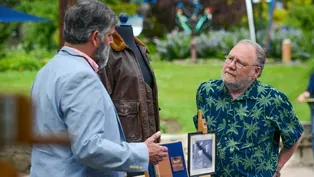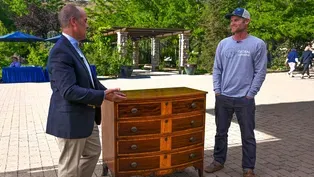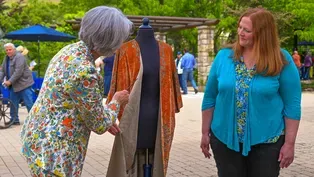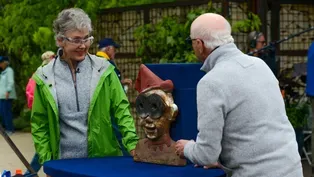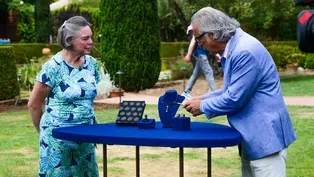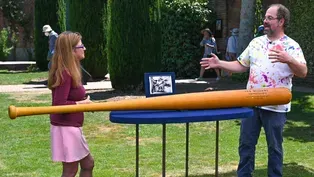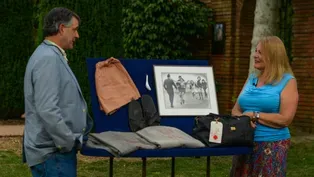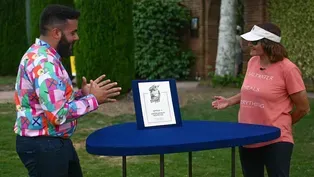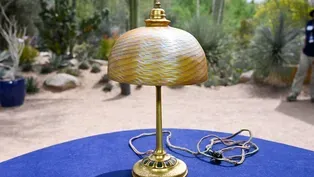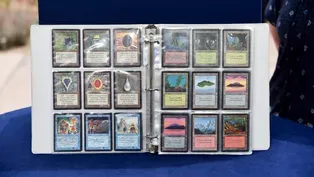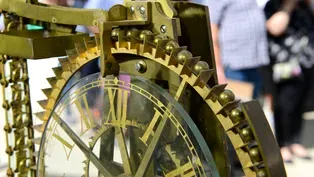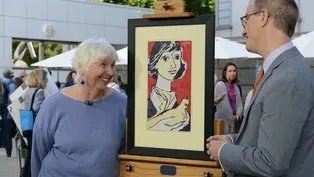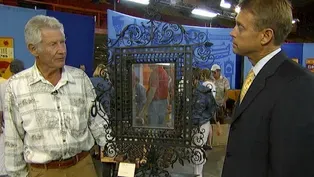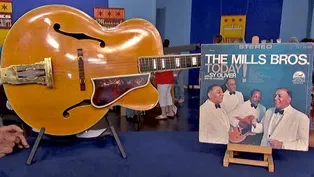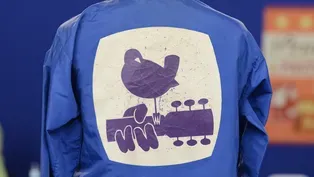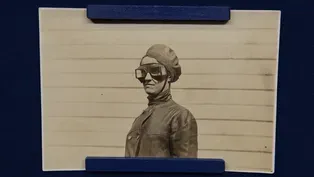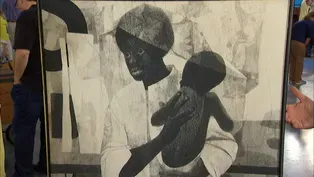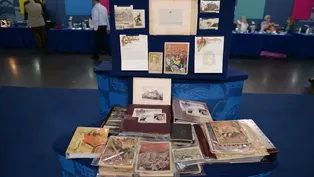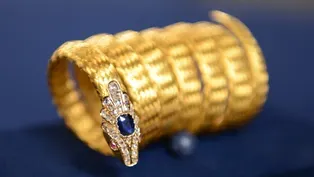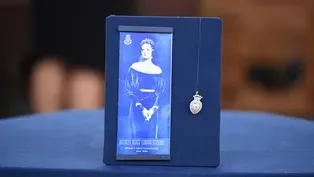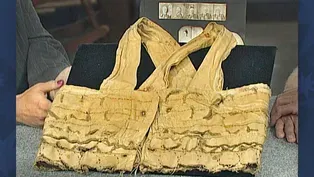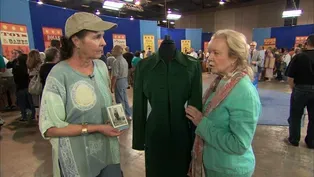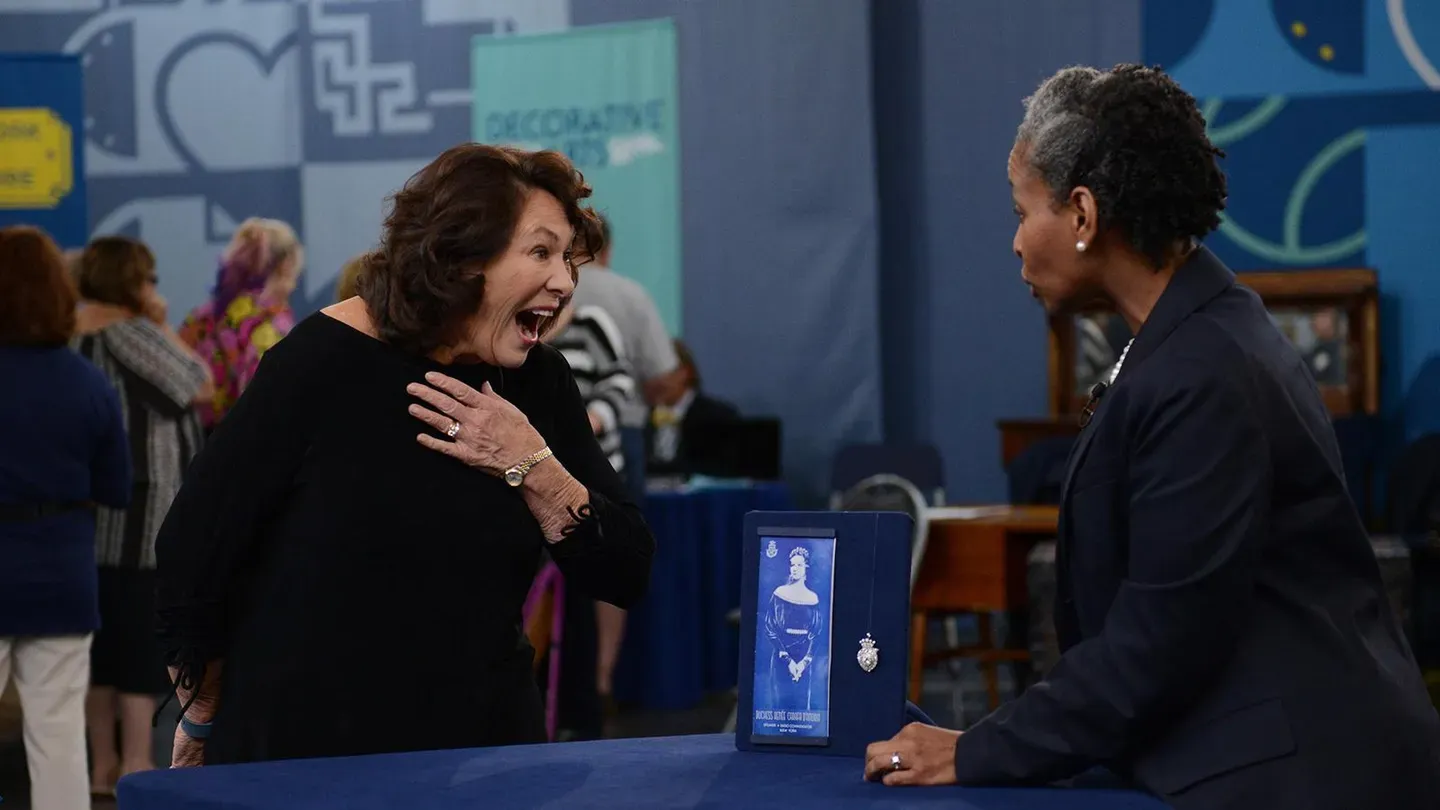

RECUT: American Stories, Part 1
Special | 22m 28sVideo has Closed Captions
Learn the stories of objects that represent American traditions and triumphs!
Celebrate the personal stories that represent American traditions and triumphs around treasures like a 1969 Woodstock jacket and program, a Bessica Raiche aviator archive, and a gold and sapphire bracelet from around 1875 in this half-hour RECUT special!
Problems with Closed Captions? Closed Captioning Feedback
Problems with Closed Captions? Closed Captioning Feedback
Funding for ANTIQUES ROADSHOW is provided by Ancestry and American Cruise Lines. Additional funding is provided by public television viewers.

RECUT: American Stories, Part 1
Special | 22m 28sVideo has Closed Captions
Celebrate the personal stories that represent American traditions and triumphs around treasures like a 1969 Woodstock jacket and program, a Bessica Raiche aviator archive, and a gold and sapphire bracelet from around 1875 in this half-hour RECUT special!
Problems with Closed Captions? Closed Captioning Feedback
How to Watch Antiques Roadshow
Antiques Roadshow is available to stream on pbs.org and the free PBS App, available on iPhone, Apple TV, Android TV, Android smartphones, Amazon Fire TV, Amazon Fire Tablet, Roku, Samsung Smart TV, and Vizio.
Buy Now
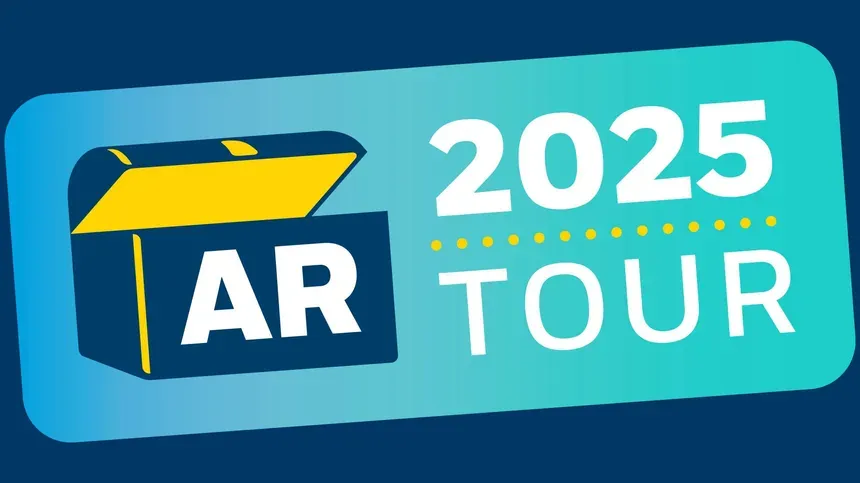
ANTIQUES ROADSHOW 2025 Tour!
Enter now for a chance to win free tickets to ANTIQUES ROADSHOW's 2025 Tour! Plus, see which cities we're headed to!Providing Support for PBS.org
Learn Moreabout PBS online sponsorshipMore from This Collection
RECUT: Idaho Botanical Garden, Part 4
Video has Closed Captions
Wrap up Season 4 of RECUT with a $50,000 appraisal at Idaho Botanical Garden! (22m 31s)
RECUT: Idaho Botanical Garden, Part 3
Video has Closed Captions
Visit the “City of Trees” for unbe-leaf-able Boise treasures in this half-hour RECUT. (22m 31s)
RECUT: Idaho Botanical Garden, Part 2
Video has Closed Captions
In this half-hour RECUT, watch breathtaking Boise appraisals at Idaho Botanical Garden. (22m 31s)
RECUT: Idaho Botanical Garden, Part 1
Video has Closed Captions
Gem State treasures sparkle in this half-hour RECUT at Idaho Botanical Garden! (22m 31s)
Video has Closed Captions
Watch wow-worthy Woodside finds in this half-hour RECUT and learn which is up to $44,000! (22m 24s)
Video has Closed Captions
In this half-hour RECUT episode, golden state treasures shine at Filoli. One is $150,000! (22m 23s)
Video has Closed Captions
Watch fascinating Filoli finds in this half-hour RECUT, including one up to $100,000! (22m 36s)
Video has Closed Captions
This season's first half-hour of RECUT wows our guests with a $200,000 to $330,000 find! (22m 30s)
RECUT: Desert Botanical Garden, Part 2
Video has Closed Captions
Phoenix treasures heat up, like one appraisal up to $35,000, in this half-hour RECUT! (22m 28s)
RECUT: Desert Botanical Garden, Part 1
Video has Closed Captions
Phenomenal Phoenix finds abound in this half-hour RECUT. One is worth up to $100,000! (22m 26s)
RECUT: Crocker Art Museum, Part 2
Video has Closed Captions
See stunning Sacramento finds like one $80,000-$125,000 treasure, in this half-hour RECUT! (22m 28s)
RECUT: Crocker Art Museum, Part 1
Video has Closed Captions
Head to California’s Crocker Art Museum for a bite-sized RECUT! One find is up to $75,000! (22m 27s)
Providing Support for PBS.org
Learn Moreabout PBS online sponsorship♪ CORAL PEÑA: "Antiques Roadshow Recut" has a collection of tales that will keep you captivated.
It was incredible.
Getting, I'm getting chills just thinking about it.
You're kidding me!
(laughing) PEÑA: Stay tuned for these moments and more.
It's "Antiques Roadshow Recut: American Stories."
♪ PEÑA: "Antiques Roadshow Recut" is highlighting stories from all across America.
APPRAISER: She was the first woman aviator in the United States.
PEÑA: Stories of success... My great-great-great-grandfather went to the Gold Rush, he made a strike.
APPRAISER: He was a '49er.
That's right.
PEÑA: Loss...
I brought a Testament that has a bullet hole in it that my great-great-uncle carried during the Civil War and he was shot through the Testament and died at the Battle of Peach Tree.
PEÑA: And some luck!
MAN: The story from my aunt says that my father won it during World War II in a poker game.
PEÑA: Starting off with memories and mementos from one of the most iconic cultural happenings of the 20th century.
Could you tell me the story of how you got these items from Woodstock?
The jacket I picked up after everything was over on Monday morning.
They were lying there in the mud, and I picked this one up and asked my girlfriend, "Do you want the other one?"
She said, "Ew, no."
And the program, there was a huge pile of them that was probably ten feet high.
They never delivered them.
They couldn't get them onto the grounds, and they got them there on Monday morning, and I guess they just dumped them there.
But I picked up a whole handful, I've still got the one.
It was called the Woodstock Music and Arts Fair, and they had asked a bunch of kids from the Institute of American Indian Arts in Santa Fe to come and be a part of it.
They flew everybody in, so we were guests of management.
It was really great, because all these guys were coming up and asking, "Where are you guys from?"
And they were all excited to see "Indians," quote-unquote.
When we first arrived there, we were given two tipis, and so when it rained, we were fine-- and with our passes, we could go to the performer pavilion and get a case of beer if we wanted and sit there dry and drink, and we had a good time.
(laughs) Well, you had probably a very different experience at Woodstock than your average person who went, because you had passes from management.
What you're discussing, bringing in the people from the Institute of American Indian Arts out of Santa Fe... Uh-huh.
...is a really well-documented story.
And obviously, you were among those people who were lucky enough to go.
Right, that's how it worked out, yeah.
And while you were there, my question is, did you watch any of the acts?
Oh, yeah, yeah.
Who did you see?
Well, I guess probably the most, what you might call the important thing, was Jimi Hendrix at the end.
I remember waking up, it was still dark, and I heard them introducing him.
So I woke up my partner and said, "Let's go down and catch this," and she was a big, huge fan.
We were ten, 15 feet away from him while he was playing, and then when he started playing "The Star-Spangled Banner," that was... something that I had never imagined.
It was incredible.
Getting, I'm getting chills just thinking about it.
Well, these are priceless memories that you have.
We do see these come up for auction from time to time.
Mm-hmm.
There were different colors.
Right.
This is, carries the original logo that was on the poster designed by a man named Arnold Skolnick.
You don't have to say Woodstock when you look at this jacket.
You see this and everybody knows this is from Woodstock.
Yeah.
But to have one of the original jackets worn by management, and as you said, there are other colors of jackets.
There's red and green.
Yeah, red was for security.
Yeah.
And then the green was for stage crew.
When these do come up for sale at auction, they traditionally sell anywhere between $2,000 and $2,500.
Mm-hmm.
And then you also mentioned the program.
Because they were never officially kind of distributed there, there were kind of stacks of them that...
Same with the tickets, that they just stopped taking tickets because people crashed the gates.
Right.
These are rare.
The value on the programs is completely dependent upon condition.
So in the condition that you have here, I would expect this one to sell anywhere in the $500 to $600 range at auction-- they have sold for as much as $1,200, but that was a near-mint, fine copy, and that's the difference condition will make on something like this.
Oh, yeah, I'm sure.
So all together, it's a really great group of objects here.
And like I said, the memories that you have from the event are worth more than anything I could put a dollar figure on.
Yeah, and I remember most of it.
(laughs) No.
MAN: I knew I had a great- grandmother.
Her name was Bessica Raiche, but I didn't know the details behind it until probably ten years ago, when my mom brought her to my attention.
She said that we had all these artifacts of hers.
APPRAISER: Who was Bessica?
What did she do?
She was the first woman aviator.
In the United States.
In the United States, yes.
She built, designed her own planes, and flew them.
Her and her husband did.
Um, when their first plane was built, they actually built it in their house, and then come to find out that they couldn't get it out, so they had to tear the front of the house off to get it, to get it out.
That's just amazing.
Yeah.
When did she take her first flight?
Her first flight, I think, was in 1908 and that was in a bi-plane.
I think she got the flying bug and built her own plane.
Her first solo flight was in 1910.
I understand she was also a medical doctor?
Yeah, she was a doctor before she became an aviator, and then due to health reasons, she had to quit the aviation business, and she went back into her medical practice.
Until today, I had never heard of your illustrious great-grandmother, either.
And many people haven't.
(chuckles) How can this be that America's first female aviator is virtually unknown outside of a tiny circle of aviation aficionados?
Yeah.
I have no idea.
Well, here you brought with us today this early medal that designates that she is America's first woman aviator.
On the back of the medal, it's dated 1910.
Correct.
You've brought a picture of Bessica Raiche.
Mm-hmm.
There she is in her plane.
Right.
And over here in the air.
Exactly.
And the most amazing thing about it is, nobody knows who she is.
Well, I'm hoping that through our conversation, maybe we can change that just a little bit.
That would be nice.
One of the items you brought is this letter from another rather famous gentleman, Harry Houdini.
Yes, it says, the "first successful aviator in Australia."
(laughs) I had no idea Harry Houdini was a pilot.
He's better known for other things.
Yeah.
But you have a treasure trove of all kinds of artifacts and images and other related material... Yeah.
...to her early aviation pioneer career.
Yes, we do.
We have quite a bit of it.
Unfortunately, her husband, when they divorced, he ended up burning a lot of the stuff-- plane drawings, the designs.
He sat in front of the fireplace and said that, "We don't need this anymore," and threw them, you know, threw them in the fire and burned them.
Oh, my goodness, that, that's... Maybe that helps explain...
Right.
...why she's not as famous as she deserves to be.
Could very well be.
The value of a Harry Houdini letter is in the $2,000 to $3,000 range at retail.
For the collection we have before us, I think a valuation at retail would be $5,000.
Okay.
Very good.
I brought a Testament that has a bullet hole in it that my great-great-uncle carried during the Civil War, and he was shot through the Testament, and died at the Battle of Peach Tree.
He actually had this...
In his pocket, yes.
...in his pocket.
And this is a photograph of him.
This is a tintype of him, yes.
We see tons of Bibles on the "Roadshow," because during the Civil War, they gave out hundreds of thousands of them.
We don't see many like this.
If I was gonna insure this and the picture, I'd insure it for $5,000.
Ooh, thank you!
That's wonderful!
This piece was originally an engagement ring of my great-aunt.
Wow.
Her name was Renée Thornton.
She was actually a coloratura soprano at the Metropolitan Opera in the 1920s.
In the '20s, okay.
Right-- after that, she divorced her husband, who was a conductor of the Met.
And she ended up marrying in the '30s, early '30s, a duke from Italy.
And she was the Duchess d'Andria, and this was her engagement ring.
My mother inherited it, and she didn't like it as an engagement ring.
So she changed the back of it, and changed it from a ring to a pendant that my mom could wear.
Okay.
It's a very beautiful piece.
Thank you very much.
I think it's from around the turn of the century.
Uh-huh.
And I think that because it is topped in platinum and backed in 14-karat yellow gold.
Wow, hm.
You can see the platinum running along the top and the yellow gold along the bottom.
If it were earlier, it would be silver-topped yellow gold.
Okay.
The diamonds around, so you have a great group of diamonds.
These are all mostly old European-cuts.
Mm-hmm.
That center diamond is a carat, about a carat 17.
And this is by calculation.
So I'm measuring and figuring out what I think it is.
Okay.
But the whole brooch, excluding the center, you have about four-and-a-half carats of diamonds.
Wow.
Okay?
Now, I do see that this bail has been changed... Mm-hmm.
And this pin stem, as well.
So there could have been marks on the back of the piece.
Mm.
And they've probably been removed with these two additions.
With the addition.
I mean, it must have been an amazing engagement ring.
Yeah, can you imagine?
I mean, just the size of it.
I can't, I mean, it's so sweet.
The heart, and then obviously, the crown up top... Up top... ...referring back to royalty.
Knowing the provenance... Mm-hmm.
...the style of the diamonds-- they're a nice color-- I think a piece like this, retail, would be $20,000.
(gasps) (laughing): Are you kidding me?
(excited squeal) (laughing): May I hug you?
(laughing) This was built by my great-great-grandfather for the Columbian Exposition in 1893, and they won a third prize.
He was a German immigrant.
Immigrates to the United States as an expert ironworker.
As we could see from this, he was very skilled.
And you could see how accomplished he was by the fact that two years after he immigrates to the United States, he is commissioned to produce the stairwell for the Statue of Liberty.
Well, I'm an avid believer of an artist named Charles McGee.
And one weekend, I went to an estate sale, and I found this one here, and I thought it was a print.
The person who sold it to me sold it to me for over $1,000.
And I said to myself, "Since it's a print, that's a lot of money."
But I wanted it so bad, so I bought it for $1,000.
I gave it to him.
Then I found out later on it wasn't a print.
It was an original piece of art made out of graphite and charcoal.
And I don't know more than that about it.
So Charles McGee was born in 1924 in South Carolina.
And at the age of ten, he came to Detroit, which would be a city that would become very important for him, and likewise, he became very important for the city.
In 1969, he put together a, an exhibition called "Seven Black Artists," which was very important in terms of the history of African American art in Detroit.
It was a seminal exhibition with a lot of important artists, including himself.
After that, he even went on to start his own gallery.
And in 1995, he had a one-man show dedicated to him at the Detroit Institute of Arts.
So he really became a fixture in Detroit.
He's still alive.
Yes.
Right now, he's 90 years old.
Right.
And is still working-- when we look at this, what we see is something that has a lot of emotion to it.
What do you think the value might be today?
I have really no idea at all.
I have no clue.
I couldn't even begin to think about what the value would be.
Okay.
Because I'm not even sure when it was really drawn, so...
Right, well, it does look like it's probably from his '60s-'70s period.
Okay.
The value that I would put on it today for an auction estimate-- it's a large work-- would be $4,000 to $6,000.
Okay, all right.
Wow.
Well, that's an improvement.
(laughs) In the 1840s... APPRAISER: Mm-hmm.
...my great-great-great- grandfather... Mm-hmm.
...Pembroke Showman...
Right.
...went to the Gold Rush.
California.
Mm-hmm, he was a '49er.
That's right.
Wow, an original.
Mm-hmm.
He made a strike, and preparing to come back to Maryland... Mm-hmm.
...where he was originally from, changed his gold in for coins.
And to guard against holdup men, he sewed this vest, and sewed the coins into the vest, which, you can see the circles.
Wow!
Where they were sewed.
That's just amazing.
Brought a stagecoach, then back, um, came through Ohio to visit with some relatives, and he stayed with them a while and liked the area, so he ended up buying 140 acres there with the gold coins.
And that farm is still in the Showman name.
I've never seen anything quite like this, I'm sure you know history of the '49 Gold Rush-- it actually started with John Sutter, who built a mill out there.
He was from Switzerland-- when they were out in the Sacramento area, they had Sutter's mill, and his foreman, James Marshall, was helping to build the mill one day, and they were scratching around and they saw these glints of gold.
Well, of course, they couldn't keep a secret.
The papers had gotten ahold of it.
The next thing you knew, you had the Gold Rush.
Mm-hmm.
Of course, mostly men, mostly trying to find their fortunes.
And there's a huge difference between the haves and the have-nots.
Mm-hmm.
Your great-great-great-great- great-grandfather was a have.
There was a lot of violence.
There was gambling, there were pleasure palaces, bars-- you name it.
And anyone coming cross country, they didn't take railroads at that time.
They took stagecoaches or horses.
So they had to do this to protect themselves.
A lot of the letters that have survived from that time... Mm-hmm.
...you'll see where it says things like, "I saw so-and-so get stabbed today for a few gold pieces" or "someone getting shot."
So trying to value something like that today, very unusual piece, but probably somewhere in the vicinity of about $2,000 to $3,000.
Is that right?
MAN: The story from my aunt says that my father won it during World War II in a poker game.
And she swears that that's the truth, so I believe her.
Where was the poker game in World War II?
Do you remember which country?
Well, he was stationed in France and went up that way.
He came in the Normandy invasion and was also involved in the Battle of the Bulge, so in, in that area.
So you don't really know very much at all about it, other than it's a snake bracelet.
I don't, sir, no.
It's an interesting design, because the first snake jewelry was the Egyptian asp.
Wow.
And it's not the time of the poker game.
It's probably 1870, 1880.
It's English.
Wow.
And I would wager that that's 18-karat gold, which is very high.
And the diamonds are very good quality, as well.
But what gives this very good value is that big sapphire.
If you could test it, which is very difficult, because you don't want to take it out... Sure.
...and it's got the gold around it, which is gonna enhance the color... Sure.
I would imagine it's Kashmir sapphire, which is the top, top, top grade of sapphire.
Do you have any idea?
No, I really don't.
When I searched on the internet, I couldn't find anything, and everybody I talked to says they've never seen anything like it, so... Well, how much would you like it to be?
Well, I'll put it this way: it doesn't really matter to me if it's a dollar.
It's a family heirloom.
It's a keepsake from my mom, who passed away in October, so it has very high sentimental value.
So, frankly, you could tell me it's worth a million dollars, and it wouldn't make a darn bit of difference to me.
Not quite, but how about about $25,000 or $27,000 retail?
Well, that's wonderful.
That's nice to know, to be able to get an appraisal and have it appraised.
A lot of the value is the fact that it's got such a wonderful stone in the center of it.
If it were a lesser stone, it might be around $18,000 or $20,000, but I'm firmly convinced that $25,000 is a very fair retail price for it.
Well, I, you know, I think that's amazing, and I'm thrilled, and it's an honor to be on "Antiques Roadshow," and it's, it's wonderful, and I'm very, very pleased.
WOMAN: This is a collection of circus memorabilia and Wild West Show.
My grandfather ran away from home when he was 12 years old.
And he went on a sailing vessel.
On the sailing vessel, he learned about rigging and taking care of the sails.
And because of that, he had the experience when he went into the circus to do that type of work.
So he worked for various circuses throughout his lifetime.
He went from Barnum & Bailey to the Wild West Show.
And then tell me about your grandmother.
My grandmother, she came from Budapest, and originally, she was a ballerina at the Budapest Opera House.
And from there, that's how she joined the circus.
I guess she ran out of work.
She met my grandfather, they married in New Orleans, and the rest is history.
And what year would that have been?
About 1906 when they got married.
And your grandfather started working for the circuses in about 1902?
1902, right.
And he was a chief rigger, and then he became property manager.
So he had to take care of all the items that got destroyed because of, maybe a train wreck, or there was a cyclone.
And he had to take pictures of all this, so I have all the original pictures.
Right.
And then my grandmother went further, and she cut out pictures and articles in the newspaper about what happened to verify what he was doing.
Yeah.
We had hundreds of images to go through in the form of real photo postcards, mounted photographs.
You also had lots of documents and letterhead signed by the owners of the circuses right here-- 101 Ranch, Barnum & Bailey Circus, signed by one of the brothers there.
And that one is a authentic pen signature.
This is just a sampling of what you have here in the binders.
Right.
We have a couple of real photo postcards here, one that was taken while the circus tent was on fire.
Right.
And then above, we have one after a cyclone damage.
We rarely, if ever, see images like this-- you're going to see some of the circus freaks, you're going to see images of the circus in action.
But these type of images are rarely seen.
On the bottom here, we have a cabinet card photo of Pawnee Bill, who was partners with Buffalo Bill.
And the top image, it says "sole survivor of Mount Pelée volcano."
And this was in St. Pierre, Martinique, and the volcano was in 1902.
30,000 to 40,000 people perished in that volcano, and it's recorded that there were two survivors, is all.
And you know why he survived?
He was in prison, and there was poor ventilation in his cell.
Oh!
His name is Ludger Sylbaris, and of course, being in the circus, they went ahead and advertised it as the sole survivor.
Well, to start off with the programs, and you have quite a few here.
But the one we've put up here is going to be a good general example of what the rest are.
They're going to be worth between about $50 to $100 each at auction, and the signed letterhead from the circus owners are going to range in value from $75 up to $250 each.
Mm-hmm.
The cabinet photo of Pawnee Bill, I would expect that at auction to bring between $400 and $600.
Wow.
The great images here in the real photo postcards would sell at auction for between, on the low end of $75 to $100 each, up to as high as $250 each for some of those fabulous images that you have.
Oh... (sighs) And the photo of Ludger Sylbaris, I consulted several other appraisers that deal in antique photographic images, and nobody has seen an image of him before in the form of a mounted photo like that.
And easily we would say at auction, we would expect that to bring between $1,000 and $2,000.
(gasps and exhales) It's one of the rarest images we've seen of anybody involved in the circus in years.
The collection you brought in today in total, I'd put an estimate at auction for between $12,000 and $16,000.
Oh, wow, wow.
There's just so many beautiful pieces in there.
Thank you so much.
I have to thank my grandma and grandpa for doing this for me.
♪ PEÑA: Thanks for watching!
We hope you've enjoyed this episode of "Antiques Roadshow Recut."
Appraisal: 1893 Wrought Iron Exhibition Piece
Video has Closed Captions
Clip: Special | 37s | Appraisal: 1893 Wrought Iron Exhibition Piece, from Rapid City Hour 1. (37s)
Appraisal: 1956 Norman Brown-owned Gibson L-5C Guitar
Video has Closed Captions
Clip: Special | 32s | Appraisal: 1956 Norman Brown-owned Gibson L-5C Guitar (32s)
Appraisal: 1969 Woodstock Jacket & Program
Video has Closed Captions
Clip: Special | 3m 41s | Appraisal: 1969 Woodstock Jacket & Program, from American Stories (3m 41s)
Appraisal: Bessica Raiche Aviator Archive, ca. 1910
Video has Closed Captions
Clip: Special | 3m 8s | Appraisal: Bessica Raiche Aviator Archive, ca. 1910 (3m 8s)
Appraisal: Charles McGee Charcoal Drawing, ca. 1965
Video has Closed Captions
Clip: Special | 1m 49s | Appraisal: Charles McGee Charcoal Drawing, ca. 1965 (1m 49s)
Appraisal: Early 20th C. Traveling Show Memorabilia
Video has Closed Captions
Clip: Special | 4m 16s | Appraisal: Early 20th C. Traveling Show Memorabilia (4m 16s)
Appraisal: English Gold & Sapphire Snake Bracelet, ca. 1875
Video has Closed Captions
Clip: Special | 2m 38s | Appraisal: English Gold & Sapphire Snake Bracelet, ca. 1875 (2m 38s)
Appraisal: Gold, Platinum & Diamond Pendant Brooch, ca. 1900
Video has Closed Captions
Clip: Special | 2m 16s | Appraisal: Gold, Platinum & Diamond Pendant Brooch, ca. 1900 (2m 16s)
Appraisal: Gold Rush Money Vest, ca. 1849
Video has Closed Captions
Clip: Special | 2m 13s | Appraisal: Gold Rush Money Vest, ca. 1849 (2m 13s)
Appraisal: Lilli Ann Western Airlines Uniform, ca. 1950
Video has Closed Captions
Clip: Special | 36s | Appraisal: Lilli Ann Western Airlines Uniform, ca. 1950 (36s)
Providing Support for PBS.org
Learn Moreabout PBS online sponsorshipSupport for PBS provided by:
Funding for ANTIQUES ROADSHOW is provided by Ancestry and American Cruise Lines. Additional funding is provided by public television viewers.


